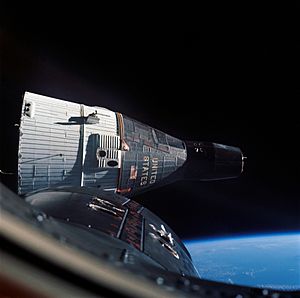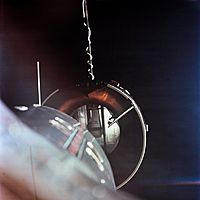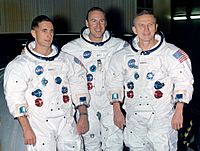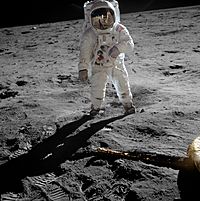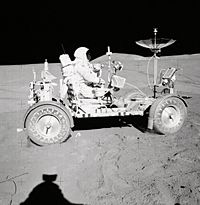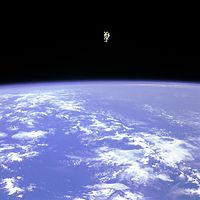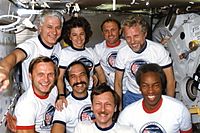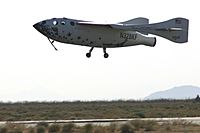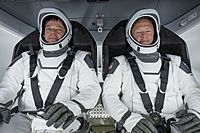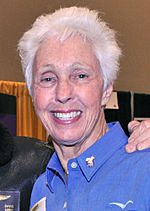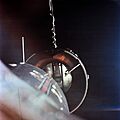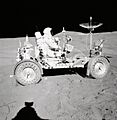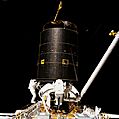List of spaceflight records facts for kids
Spaceflight records and firsts are special achievements in space travel. They are usually divided into two main types: flights with people (crewed) and flights without people (uncrewed). In the early days, scientists also sent animals into space to see if it was safe for humans to go.
The idea of "firsts" in spaceflight is like the "firsts" in airplane history. It's also linked to the Space Race. In the 1950s and 1960s, the Soviet Union and the United States raced to be the first to do amazing things in space. For example, in 1957, the Soviet Union launched Sputnik 1, the first artificial satellite to orbit Earth. In 1961, Soviet cosmonaut Yuri Gagarin became the first person to go to space and orbit our planet. Then, in 1969, American astronaut Neil Armstrong was the first person to walk on the Moon. Since 1972, no human has traveled beyond low Earth orbit.
In the 1970s, the Soviet Union focused on building space stations where people could live for longer and longer times. In the 1980s, the United States started using its Space Shuttles. These shuttles could carry more astronauts, meaning more people could be in space at once. Later, the Soviet Union and the United States worked together on space projects. This led to the International Space Station (ISS), which has had people living on it continuously for over 20 years.
Other space firsts involve different groups of people and private companies. Many countries have now sent someone to space. In 1963, Valentina Tereshkova became the first woman in space. In the early 2000s, private companies also started sending people to space. In 2004, SpaceShipOne was the first private spacecraft to carry people into space (though not into orbit). In 2020, SpaceX's Dragon 2 became the first privately built spacecraft to take astronauts to orbit and the ISS. As of 2025, the uncrewed probe Voyager 1 is the farthest object from Earth made by humans. It is now leaving our Solar System.
Contents
First Human Spaceflights by Country
This table shows the first times different countries sent their own astronauts into space.
| Country | Mission | Crew | Spacecraft | Launch vehicle | Date | Type |
|---|---|---|---|---|---|---|
| Vostok 1 | Yuri Gagarin | Vostok 3KA | Vostok-K | 12 April 1961 | Orbital | |
| Mercury-Redstone 3 (Freedom 7) | Alan Shepard | Mercury Spacecraft No.7 | Mercury-Redstone | 5 May 1961 | Sub-orbital | |
| Mercury-Atlas 6 (Friendship 7) | John Glenn | Mercury Spacecraft No.13 | Atlas LV-3B | 20 February 1962 | Orbital | |
| Soyuz TM-14 | Aleksandr Viktorenko, Aleksandr Kaleri, Klaus-Dietrich Flade | Soyuz-TM | Soyuz-U2 | 17 March 1992 | Orbital | |
| Shenzhou 5 | Yang Liwei | Shenzhou spacecraft | Long March 2F | 15 October 2003 | Orbital |
Amazing Human Spaceflight Firsts
Sometimes, there are small disagreements about what counts as "space." Most records follow the FAI rule, which says space starts at 100 kilometers (62.14 miles) above Earth. NASA and the US Air Force use a slightly lower border of 80.47 kilometers (50 miles).
| What was First? | Person(s) | Mission | Country | Date |
|---|---|---|---|---|
* First person to reach space
|
Yuri Gagarin | Vostok 1 | 12 April 1961 | |
* First person to make a suborbital flight (up and down)
|
Alan Shepard | Freedom 7 | 5 May 1961 | |
* First person in space for over 24 hours
|
Gherman Titov | Vostok 2 | 6 August 1961 – 7 August 1961 |
|
* First group flight (more than one spacecraft at once)
|
Andrian Nikolayev and Pavel Popovich | Vostok 3 and Vostok 4 | 12 August 1962 – 15 August 1962 |
|
* First woman in space
|
Valentina Tereshkova | Vostok 6 | 16 June 1963 – 19 June 1963 |
|
* First three-person spaceflight
|
Vladimir Mikhaylovich Komarov, Konstantin Feoktistov, and Boris Yegorov | Voskhod 1 | 12 October 1964 – 13 October 1964 |
|
| * First spacewalk | Alexei Leonov | Voskhod 2 | 18 March 1965 | |
| * First time spacecraft changed their orbit | Gus Grissom, John W. Young | Gemini 3 | 23 March 1965 | |
| * First people to spend one week in space | Gordon Cooper, Pete Conrad | Gemini 5 | 21 August 1965 – 29 August 1965 |
|
* First Space rendezvous (meeting in space)
|
Frank Borman, Jim Lovell and Walter Schirra, Thomas Stafford | Gemini 7 and Gemini 6A | 15 December 1965 – 16 December 1965 |
|
| * First space docking (connecting two spacecraft) | Neil Armstrong, David Scott | Gemini 8 and Agena | 16 March 1966 | |
| * First spaceflight death (during landing) | Vladimir Komarov | Soyuz 1 | 23 April 1967 – 24 April 1967 |
|
* First people to go beyond low Earth orbit (LEO)
|
Frank Borman, Jim Lovell, Bill Anders | Apollo 8 | 24 December 1968 – 25 December 1968 |
|
* First time two crewed spacecraft docked
|
Vladimir Shatalov, Boris Volynov, Aleksei Yeliseyev, Yevgeny Khrunov | Soyuz 4 and Soyuz 5 | 16 January 1969 | |
* First Moon landing
|
Neil Armstrong, Buzz Aldrin | Apollo 11 | 20 July 1969 | |
| * First time seven people were in space at once | Georgi Shonin, Valeri Kubasov, Anatoly Filipchenko, Vladislav Volkov, Viktor Gorbatko, Vladimir Shatalov, Aleksei Yeliseyev | Soyuz 6, Soyuz 7, Soyuz 8 | 13 October 1969 – 16 October 1969 |
|
| * Farthest humans have traveled from Earth | Jim Lovell, Jack Swigert, Fred Haise | Apollo 13 | 11 April 1970 – 17 April 1970 |
|
| * First people to spend two weeks in space | Andrian Nikolayev, Vitali Sevastyanov | Soyuz 9 | 1 June 1970 – 19 June 1970 |
|
* First crewed space station
|
Georgi Dobrovolski, Viktor Patsayev, Vladislav Volkov | Soyuz 11 and Salyut 1 | 7 June 1971 – 29 June 1971 |
|
| * First people to travel in a wheeled vehicle on another planet (the Moon) | Dave Scott, Jim Irwin | Apollo 15 | 31 July 1971– 2 August 1971 |
|
| * First international docking in space | Thomas P. Stafford, Vance D. Brand, Donald K. Slayton (USA) and Alexei Leonov, Valeri Kubasov (USSR) | Apollo CSM, Soyuz 19 | 17 July 1975 | |
| * First orbital spaceflight by a winged spacecraft (Space Shuttle) | John W. Young, Robert L. Crippen | STS-1 | 12 April 1981 | |
| * First re-use of a spacecraft for orbital flight | Joe H. Engle, Richard H. Truly | STS-2 | 12 November 1981 | |
| * First four-person spaceflight | Vance Brand, Robert F. Overmyer, Joseph P. Allen, William B. Lenoir | STS-5 | 11 November 1982 – 16 November 1982 |
|
| * First five-person spaceflight | Robert L. Crippen, Frederick H. Hauck, John M. Fabian, Sally K. Ride, Norman E. Thagard | STS-7 | 18 June 1983 – 24 June 1983 |
|
| * First six-person spaceflight | John W. Young, Brewster H. Shaw, Owen K. Garriott, Robert A. Parker, Byron K. Lichtenberg (USA) and Ulf Merbold (Germany) | STS-9 | 28 November 1983 – 8 December 1983 |
|
| * First untethered spacewalk (floating freely) | Bruce McCandless II | STS-41-B | 7 February 1984 | |
| * First spacewalk by a woman | Svetlana Savitskaya | Soyuz T-12 | 25 July 1984 | |
| * First seven-person spaceflight | Robert L. Crippen, Jon A. McBride, Kathryn D. Sullivan, Sally K. Ride, David C. Leestma, Paul D. Scully-Power (USA) and Marc Garneau (Canada) | STS-41-G | 5 October 1984 – 13 October 1984 |
|
| * First two women in space at the same time | Kathryn D. Sullivan, Sally K. Ride | STS-41-G | 5 October 1984 – 13 October 1984 |
|
| * First eight-person spaceflight | Henry W. Hartsfield, Steven R. Nagel, Bonnie J. Dunbar, James F. Buchli, Guion S. Bluford (USA), Reinhard Furrer, Ernst Messerschmid (West Germany), and Wubbo Ockels (Netherlands) | STS-61-A | 30 October 1985 – 6 November 1985 |
|
| * First deaths during launch | Francis "Dick" Scobee, Michael J. Smith, Ellison Onizuka, Judith Resnik, Ronald McNair, Sharon Christa McAuliffe, Gregory Jarvis | STS-51-L | 28 January 1986 | |
| * First space station-to-space station flight | Leonid Kizim, Vladimir Solovyov | Soyuz T-15 from Mir to Salyut 7 and back to Mir | 15 March 1986 – 16 July 1986 |
|
| * First 12 people in space at the same time | Seven US astronauts, three Russian cosmonauts, and one Japanese journalist | STS-35, Mir EO-7, Soyuz TM-10Soyuz TM-11 | 2 December 1990 – 10 December 1990 |
|
* First civilian to use a commercial space flight
|
Toyohiro Akiyama (Japan) | Soyuz TM-10, Soyuz TM-11 | 2 December 1990 – 10 December 1990 |
|
| * First three women in space at the same time | Millie Hughes-Fulford, Tamara E. Jernigan, M. Rhea Seddon | STS-40 | 5 June 1991 – 14 June 1991 |
|
| * First three-person spacewalk | Pierre J. Thuot, Richard J. Hieb, Thomas D. Akers | STS-49 | 13 May 1992 | |
| * First 13 people in space at the same time | Seven US astronauts, five Russian cosmonauts, and one US astronaut | STS-67, Mir, Soyuz TM-20, Soyuz TM-21 | 14 March 1995 – 18 March 1995 |
|
| * First 10 people in a single spacecraft (docked) | Six US astronauts and four Russian cosmonauts | STS-71, Mir, Soyuz TM-21 | 29 June 1995 – 4 July 1995 |
|
| * First space tourist | Dennis Tito | Soyuz TM-32/31, ISS EP-1 | April 28, 2001 – May 6, 2001 |
|
| * First privately funded human space flight (suborbital) | Mike Melvill | SpaceShipOne flight 15P | 21 June 2004 | |
| * First 13 people in a single spacecraft (docked) | Seven US astronauts, two Russian cosmonauts, two Canadian astronauts, one Belgian astronaut, one Japanese astronaut | ISS, Soyuz TMA-14, Soyuz TMA-15, STS-127 | 17 July 2009 | |
| * First four women in space at the same time (docked) | Two US astronauts, one Japanese astronaut, one US astronaut | STS-131 and ISS Expedition 23 | 5 April 2010 – 20 April 2010 |
|
* First all-woman spacewalk
|
Christina Koch, Jessica Meir | ISS Expedition 61 | 18 October 2019 | |
* First astronauts launched into orbit on a commercial spacecraft
|
Bob Behnken, Doug Hurley | Crew Dragon Demo-2 | 30 May 2020 – 31 May 2020 |
|
| * First 16 people in space (above 50 miles) at the same time | Seven ISS astronauts, three Tiangong astronauts, six Unity astronauts | Soyuz MS-18, SpaceX Crew-2, Shenzhou-12, Virgin Galactic Unity-22 | 11 July 2021 | |
| * First 14 people in space (above 100 km) at the same time | Seven ISS astronauts, three Tiangong astronauts, four New Shepard astronauts | Soyuz MS-18, SpaceX Crew-2, Shenzhou-12, Blue Origin NS-16 | 20 July 2021 | |
* First orbital spaceflight with an all-private crew
|
Jared Isaacman, Hayley Arceneaux, Christopher Sembroski, Sian Proctor | Inspiration4 | 16 September 2021 – 18 September 2021 |
|
* First person with a physical disability in space
|
Hayley Arceneaux | Inspiration4 | 16 September 2021 – 18 September 2021 |
|
| * First 19 people in space (above 100 km) at the same time | Ten ISS astronauts, three Tiangong astronauts, six New Shepard astronauts | Soyuz MS-19, Shenzhou-13, SpaceX Crew-3, Soyuz MS-20, Blue Origin NS-19 | 11 December 2021 | |
* First flight to a space station with an all-private crew
|
Michael López-Alegría, Larry Connor, Mark Pathy, Eytan Stibbe | Axiom Mission 1 To ISS | 8 April 2022 – 18 April 2022 |
|
| * First time two crewed space stations were continuously lived in at the same time | ISS and TSS crews | ISS and TSS |
|
5 June 2022 – |
| * First 20 people in space (above 50 miles) at the same time | Eleven ISS astronauts, three Tiangong astronauts, six Unity astronauts | Axiom Mission 2, Soyuz MS-23, SpaceX Crew-6, Shenzhou 15, Virgin Galactic Unity 25 | 25 May 2023 | |
| * First 17 people in orbit at the same time | Eleven ISS astronauts, six Tiangong astronauts | Axiom Mission 2, Soyuz MS-23, SpaceX Crew-6, Shenzhou 15, Shenzhou 16 | 30 May 2023 - 31 May 2023 |
|
| * First person to spend 1000 days in space | Oleg Kononenko | Expedition 71 | 5 June 2024 | |
| * First woman to fly on the first crewed flight of an orbital spacecraft | Sunita Williams | Boeing CFT | 5 June 2024 |
Most Spaceflights
Most Launches from Earth
- 10 launches
- Frederick W. Sturckow (USA), using the Space Shuttle and SpaceShipTwo (1998–2024).
Note: Six of the SpaceShipTwo flights went above the US definition of space (80.47 km or 50 miles). However, they did not reach the Kármán line (100 km or 62.14 miles), which is the international standard for space records.
Most Orbital Launches from Earth
- 7 launches
- Jerry L. Ross (USA), on the Space Shuttle (1985–2002)
- Franklin Chang Díaz (Costa Rica/USA), on the Space Shuttle (1986–2002)
Most Orbital Launches Overall
- 7 launches
- John W. Young (USA) launched from Earth 6 times and from the Moon once (1965–1983)
- Jerry L. Ross (USA), on the Space Shuttle (1985–2002)
- Franklin Chang Díaz (Costa Rica/USA), on the Space Shuttle (1986–2002)
Largest Number of Different Spacecraft Types Used
- 3 spacecraft types
- Walter Schirra (USA) – flew on a Mercury, Gemini, and Apollo spacecraft (1962–1968)
- John W. Young (USA) – flew on a Gemini, Apollo, and Space Shuttle (1965–1983)
- Soichi Noguchi (Japan) – flew on a Space Shuttle, Soyuz, and SpaceX Crew Dragon (2005–2020)
- Shane Kimbrough (USA) – flew on a Space Shuttle, Soyuz, and SpaceX Crew Dragon (2008–2021)
- Akihiko Hoshide (Japan) – flew on a Space Shuttle, Soyuz, and SpaceX Crew Dragon (2008–2021)
- Thomas Marshburn (USA) – flew on a Space Shuttle, Soyuz, and SpaceX Crew Dragon (2007–2021)
- Koichi Wakata (Japan) – flew on a Space Shuttle, Soyuz, and SpaceX Crew Dragon (1996–2022)
- Peggy Whitson (USA) – flew on a Space Shuttle, Soyuz, and SpaceX Crew Dragon (2002–2023)
- Michael López-Alegría (USA) – flew on a Space Shuttle, Soyuz, and SpaceX Crew Dragon (1995–2024)
- Michael Barratt (USA) – flew on a Soyuz, Space Shuttle, and SpaceX Crew Dragon (2009–2024)
- Barry Wilmore (USA) – flew on a Space Shuttle, Soyuz, and Boeing Starliner (2009–2024)
- Sunita Williams (USA) – flew on a Space Shuttle, Soyuz, and Boeing Starliner (2006–2024)
Largest Number of Different Launch Sites
- 3 sites
- Sunita Williams (USA) - Kennedy Space Center, Baikonur Cosmodrome, Cape Canaveral Space Force Station
- Barry E. Wilmore (USA) - Kennedy Space Center, Baikonur Cosmodrome, Cape Canaveral Space Force Station
- Frederick W. Sturckow (USA) – Kennedy Space Center, Mojave Air and Space Port, and Spaceport America
- John Young (USA) - Cape Kennedy Air Force Station, Kennedy Space Center, Descartes Highlands (from the Moon)
- Neil Armstrong (USA) - Cape Kennedy Air Force Station, Kennedy Space Center, Tranquility Base (from the Moon)
- Buzz Aldrin (USA) - Cape Kennedy Air Force Station, Kennedy Space Center, Tranquility Base (from the Moon)
- Pete Conrad (USA) - Cape Kennedy Air Force Station, Kennedy Space Center, Ocean of Storms (from the Moon)
- Alan Shepard (USA) - Cape Kennedy Air Force Station, Kennedy Space Center, Fra Mauro (from the Moon)
- David Scott (USA) - Cape Kennedy Air Force Station, Kennedy Space Center, Hadley Rille (from the Moon)
- Gene Cernan (USA) - Cape Kennedy Air Force Station, Kennedy Space Center, Taurus-Littrow (from the Moon)
Time in Space Records
Most Time in Space (Total)
The record for most time spent in space is held by Russian cosmonaut Oleg Kononenko. He has spent over 1000 days in space across five missions. He broke the previous record held by Gennady Padalka on February 4, 2024. Kononenko also became the first person to reach 900 and 1,000 days in space.
Here are the top space travelers with the most total time in space:
Color key:
- Currently in space
- Active (could fly again)
- Retired (no longer flying)
- Deceased (passed away)
| Rank | Person | Days | Flights | Status | Nationality |
|---|---|---|---|---|---|
| 1 | Oleg Kononenko | 1565.77 | 5 | Active | |
| 2 | Gennady Padalka | 878.480 | 5 | Retired | |
| 3 | Yuri Malenchenko | 827.389 | 6 | Retired | |
| 4 | Sergei Krikalev | 803.371 | 6 | Retired | |
| 5 | Aleksandr Kaleri | 769.276 | 5 | Retired | |
| 6 | Sergei Avdeyev | 747.593 | 3 | Retired | |
| 7 | Anton Shkaplerov | 709.336 | 4 | Retired | |
| 8 | Valeri Polyakov | 678.690 | 2 | Deceased | |
| 9 | Peggy Whitson | 675.158 | 4 | Active | |
| 10 | Fyodor Yurchikhin | 672.860 | 5 | Retired |
Ten Longest Human Spaceflights
These are the longest single trips humans have made to space.
| # | Time in Space | Crew | Country | Launch Date (Craft) | Landing Date (Craft) | Space Station or Mission |
|---|---|---|---|---|---|---|
| 1 | 437.7 days | Valeri Polyakov | 1994-01-08 (Soyuz TM-18) | 1995-03-22 (Soyuz TM-20) | Mir | |
| 2 | 379.6 days | Sergey Avdeev | 1998-08-13 (Soyuz TM-28) | 1999-08-28 (Soyuz TM-29) | Mir | |
| 3 | 370.9 days | Sergey Prokopyev | 2022-09-21 (Soyuz MS-22) | 2023-09-27 (Soyuz MS-23) | International Space Station | |
| Dmitry Petelin | ||||||
| Francisco Rubio | ||||||
| 4 | 365.9 days | Vladimir Titov | 1987-12-21 (Soyuz TM-4) | 1988-12-21 (Soyuz TM-6) | Mir | |
| Musa Manarov | ||||||
| 5 | 355.2 days | Pyotr Dubrov | 2021-04-09 (Soyuz MS-18) | 2022-03-30 (Soyuz MS-19) | International Space Station | |
| Mark T. Vande Hei | ||||||
| 6 | 340.4 days | Mikhail Kornienko | 2015-03-27 (Soyuz TMA-16M) | 2016-03-01 (Soyuz TMA-18M) | International Space Station, ISS year-long mission |
|
| Scott Kelly | ||||||
| 7 | 328.6 days | Christina Koch | 2019-03-15 (Soyuz MS-12) | 2020-02-06 (Soyuz MS-13) | International Space Station | |
| 8 | 326.5 days | Yuri Romanenko | 1987-02-05 (Soyuz TM-2) | 1987-12-29 (Soyuz TM-3) | Mir | |
| 9 | 311.8 days | Sergei Krikalev | 1991-05-18 (Soyuz TM-12) | 1992-03-25 (Soyuz TM-13) | Mir | |
| 10 | 289.2 days | Peggy Whitson | 2016-11-17 (Soyuz MS-03) | 2017-09-03 (Soyuz MS-04) | International Space Station |
Longest Single Flight by a Woman
NASA astronaut Christina Koch holds the record for the longest single spaceflight by a woman. She spent 328 days in space, returning on February 6, 2020. She broke the record of NASA astronaut Peggy Whitson, who spent 289 days in space from 2016-17.
Longest Continuous Human Presence in Space
People have been living in space continuously since October 31, 2000. This started when Soyuz TM-31 was launched and docked with the International Space Station two days later.
Longest Continuous Occupation of a Spacecraft
The International Space Station has been continuously occupied by Russian and US crew members since November 2, 2000. It broke the record of the Soviet/Russian Space Station Mir on October 23, 2010.
Longest Solo Flight
Valery Bykovsky flew alone for 4 days and 23 hours in Vostok 5 in June 1963. This was a space endurance record at the time. Later, during the Apollo 16 mission, Ken Mattingly orbited the Moon alone for over 3 days and 9 hours.
Longest Time on the Lunar Surface
Eugene Cernan and Harrison Schmitt of the Apollo 17 mission stayed on the Moon for 74 hours, 59 minutes, and 40 seconds (over 3 days). This was after they landed on December 11, 1972. They performed three spacewalks totaling 22 hours and 3 minutes.
Speed and Altitude Records
Farthest Humans from Earth
The Apollo 13 crew (Jim Lovell, Fred Haise, and Jack Swigert) traveled the farthest from Earth. They were 400,171 kilometers (248,655 miles) away when they passed over the far side of the Moon. This record was set on April 15, 1970.
Highest Altitude for Crewed Non-Lunar Mission
The Gemini 11 crew, Charles Conrad, Jr. and Richard F. Gordon, Jr., reached a record height of 739.2 nautical miles (1,369 kilometers) on September 14, 1966. They did this by firing their Agena Target Vehicle rocket engine.
Fastest Speed by Humans
The Apollo 10 crew (Thomas Stafford, John W. Young, and Eugene Cernan) achieved the highest speed relative to Earth ever by humans. They reached 39,897 kilometers per hour (24,791 miles per hour) on May 26, 1969. This is about 32 times the speed of sound.
The fastest uncrewed spacecraft is the Parker Solar Probe, which reached 176 kilometers per second (about 395,000 miles per hour) relative to the Sun in September 2023.
Age Records
Earliest-Born Person to Reach Space
Suborbital Flight
- Man: Joe Walker (born February 20, 1921), on X-15 Flight 90 on July 19, 1963.
- Woman: Wally Funk (born February 1, 1939), on Blue Origin NS-16, on July 20, 2021.
Orbital Spaceflight
- Man: Georgy Beregovoy (born April 15, 1921), on Soyuz 3 on October 26, 1968.
- Woman: Valentina Tereshkova (born March 6, 1937), on Vostok 6 on June 16–19, 1963.
Youngest Person in Space
Suborbital Flight
- Man: Oliver Daemen (aged 18 years and 11 months), on Blue Origin NS-16, on July 20, 2021.
- Woman: Anastatia Mayers (aged 18 years, 10 months, and 14 days), on Galactic 02, on August 10, 2023.
Orbital Spaceflight
- Man: Gherman Titov (aged 25 years), on Vostok 2 on August 6, 1961.
- Woman: Valentina Tereshkova (aged 26 years), on Vostok 6 on June 16–19, 1963.
Oldest Person in Space
Suborbital Flight
- Man: Ed Dwight (aged 90 years, 8 months, and 10 days), on Blue Origin NS-25, on May 19, 2024.
- Woman: Wally Funk (aged 82 years, 5 months, and 19 days), on Blue Origin NS-16, on July 20, 2021.
Orbital Spaceflight
- Man: John Glenn (aged 77 years and 103 days), on STS-95 on October 29, 1998.
- Woman: Peggy Whitson (aged 63 years and 101 days), on Axiom Mission 2 on May 21, 2023.
Spacewalk Records
Most Spacewalks (Number and Duration)
These records are for the total number of spacewalks and the total time spent outside a spacecraft.
- Man: Anatoly Solovyev, with 16 spacewalks for a total of 82 hours and 21 minutes.
- Woman: Peggy Whitson, with 10 spacewalks for a total of 60 hours and 21 minutes.
Longest Single Spacewalk
The longest single spacewalk lasted 8 hours and 56 minutes. It was performed by James Voss and Susan Helms on March 11, 2001, during an ISS assembly mission.
Greatest Distance from a Spacecraft During a Spacewalk
- On a planetary body (the Moon): 7.6 kilometers (4.7 miles). This was achieved by Gene Cernan and Harrison Schmitt during Apollo 17 on December 12, 1972. They drove the Lunar Roving Vehicle far from their lunar lander.
- In orbit: about 100 meters (330 feet). This record was set by Bruce McCandless on STS-41-B on February 7, 1984. He was using a special jetpack called the Manned Maneuvering Unit (MMU) to float freely without a tether.
Oldest Person to Perform a Spacewalk
- Man: Thomas Marshburn (aged 61), during ISS Expedition 66.
- Woman: Peggy Whitson, (aged 56), during ISS Expedition 50.
Animal Records
First Animals in Space
The first animals in space were fruit flies. They were launched by the United States in 1947 on a V-2 rocket. They were also the first animals to return safely from space. Albert II, a monkey, became the first mammal in space in 1949 but did not survive. The first dogs in space, "Tsygin" and "Dezik," were launched by the Soviet Union in 1951 and returned safely.
First Animal in Orbit
Laika, a Soviet dog, was the first animal to orbit Earth on November 3, 1957, aboard Sputnik 2. She did not survive the mission. Belka and Strelka were the first dogs to safely return from orbit on August 19, 1960.
First Great Ape in Space
On January 31, 1961, the chimpanzee Ham became the first great ape in space during NASA's Mercury-Redstone 2 mission.
Longest Canine Single Flight
Soviet dogs Veterok and Ugolyok spent 22 days in orbit aboard Cosmos 110 in 1966 before landing safely.
First Animals Beyond Low Earth Orbit
A group of animals, including Russian tortoises, wine flies, and mealworms, flew around the Moon aboard the Soviet Zond 5 spacecraft on September 18, 1968. This was the first time any spacecraft returned safely to Earth from the Moon.
Notable Uncrewed or Non-Human Spaceflights
| What it was about: | Spacecraft | Event | Origin | Date |
|---|---|---|---|---|
| Earth | MW 18014 (A-4(V-2)) | First rocket to reach space (suborbital flight). | 20 June 1944 | |
| Earth | V-2 No. 20 | First living organisms (fruit flies) in space. They were successfully recovered. | 20 February 1947 | |
| Earth | R-1V | First dogs in space (suborbital flight). Successfully recovered. | 22 July 1951 | |
| Earth | Sputnik 1 | First satellite in orbit. | 4 October 1957 | |
| Earth | Sputnik 2 | First animal in orbit, Laika, a dog. | 3 November 1957 | |
| Moon | Luna 1 | First flyby (passing close by). | 4 January 1959 | |
| Moon | Luna 2 | First impact on another celestial body. | 14 September 1959 | |
| Moon | Luna 3 | First image of the Moon's far side. | 7 October 1959 | |
| Earth | Korabl-Sputnik 2 | First living beings recovered from orbit. | 19 August 1960 | |
| Venus | Mariner 2 | First planetary flyby with communication. | 14 December 1962 | |
| Mars | Mariner 4 | First flyby and first pictures of a planet. | 14 July 1965 | |
| Moon | Luna 9 | First soft landing and first pictures from the lunar surface. | 3 February 1966 | |
| Venus | Venera 3 | First impact on Venus. | 1 March 1966 | |
| Moon | Luna 10 | First orbiter of the Moon. | 3 April 1966 | |
| Docking | Cosmos 186, Cosmos 188 | First automated docking of uncrewed spacecraft. | 30 October 1967 | |
| Moon | Zond 5 | First to circle the Moon and return to Earth. Also, first animals to circle the Moon (Russian tortoises). | 15 September 1968 | |
| Moon | Luna 16 | First automated sample return from the Moon. | 24 September 1970 | |
| Moon | Luna 17 | First robotic roving vehicle, Lunokhod 1. | 17 November 1970 | |
| Venus | Venera 7 | First soft landing on another planet. | 15 December 1970 | |
| Earth | Salyut 1 | First space station. | 19 April 1971 | |
| Mars | Mariner 9 | First orbiter of Mars. | 14 November 1971 | |
| Mars | Mars 3 | First soft landing on Mars. | 2 December 1971 | |
| Jupiter | Pioneer 10 | First flyby of Jupiter. | 4 December 1973 | |
| Mercury | Mariner 10 | First flyby of Mercury. | 29 March 1974 | |
| Mars | Viking 1 | First surface-level pictures of Mars. | 20 July 1976 | |
| Saturn | Pioneer 11 | First flyby of Saturn. | 1 September 1979 | |
| Venus | Venera 13 | First sound recording made on another planet. | 1 March 1982 | |
| Trans-Neptunian region | Pioneer 10 | First to travel past the orbit of Neptune. | 13 June 1983 | |
| Uranus | Voyager 2 | First flyby of Uranus. | 24 January 1986 | |
| Comet Halley | Vega 1 | First comet flyby with pictures. | 6 March 1986 | |
| Earth | Mir Core Module, Kvant-1 | First modular space station (built in pieces). | 9 April 1987 | |
| Orbital Spaceplane | Buran | First fully automated orbital flight of a spaceplane. | 15 November 1988 | |
| Neptune | Voyager 2 | First flyby of Neptune. | 25 August 1989 | |
| 951 Gaspra | Galileo | First asteroid flyby. | 29 October 1991 | |
| Jupiter | Galileo | First orbiter of Jupiter. | 8 December 1995 | |
| Mars | Mars Pathfinder | First automated roving vehicle on Mars, Sojourner. | 4 July 1997 | |
| 433 Eros | NEAR Shoemaker | First asteroid orbiter. | 14 February 2000 | |
| 433 Eros | NEAR Shoemaker | First asteroid soft landing. | 12 February 2001 | |
| Saturn | Cassini orbiter | First orbiter of Saturn. |
|
1 July 2004 |
| Titan | Huygens probe | First soft landing on Titan. | 14 January 2005 | |
| Comet Tempel 1 | Deep Impact | First comet impact. | 4 July 2005 | |
| 25143 Itokawa | Hayabusa | First sample return from an asteroid. | 13 June 2010 | |
| Mercury | MESSENGER | First orbiter of Mercury. | 17 March 2011 | |
| International Space Station | SpaceX Dragon 1 | First commercial spacecraft to connect with the International Space Station. | 25 May 2012 | |
| Interstellar medium | Voyager 1 | First spacecraft to leave our solar system and enter interstellar space. | 25 August 2012 | |
| 67P/Churyumov–Gerasimenko | Rosetta | First comet orbiter. | 6 August 2014 | |
| Mars | MOM | First Asian nation to orbit Mars and first in the world to do so on the first try. | 24 September 2014 | |
| 67P/Churyumov–Gerasimenko | Philae | First comet soft landing. | 12 November 2014 | |
| Ceres | Dawn | First dwarf planet orbiter. | 6 March 2015 | |
| Pluto | New Horizons | First flyby of Pluto and its moons. First to explore the Kuiper belt. | 14 July 2015 | |
| Earth | Falcon 9 (B1021) | First re-flight of an orbital rocket stage. | 30 March 2017 | |
| Moon | Chang'e 4 | First soft landing on the far side of the Moon. | 3 January 2019 | |
| 101955 Bennu | OSIRIS-REx | Smallest body to be orbited by a spacecraft and closest ever orbit. | 12 June 2019 | |
| Moon | Chang'e 5 | First robotic rendezvous and docking of two spacecraft in lunar orbit. | 5 December 2020 | |
| Mars | Ingenuity | First controlled, powered flight by a helicopter on another planet. | 19 April 2021 | |
| Moon | Chandrayaan-3 | First soft landing at the Moon's south polar region. | 23 August 2023 | |
| Sun | Parker Solar Probe | Highest velocity of a spacecraft relative to the Sun and closest approach to the Sun. | 27 September 2023 | |
| Moon | IM-1 Odysseus | First successful commercial and first cryogenic lunar landing. | 22 February 2024 | |
| Earth | Falcon 9 (B1062) | Most flights and landings of a single orbital rocket stage: 20. | 13 April 2024 |
Images for kids
- First images of Earth from space
- Human presence in space
- List of crewed spacecraft
- List of cumulative spacewalk records
- List of International Space Station spacewalks
- List of Mir spacewalks
- List of spacewalkers
- List of spacewalks 2000–2014
- List of spacewalks and moonwalks 1965–1999
- List of spacewalks since 2015
- Manned Maneuvering Unit
- Omega Speedmaster
- Simplified Aid For EVA Rescue
- Space suit
- Suitport
- Timeline of space exploration, list of firsts in space exploration
See also
 In Spanish: Anexo:Récords de vuelos espaciales para niños
In Spanish: Anexo:Récords de vuelos espaciales para niños


